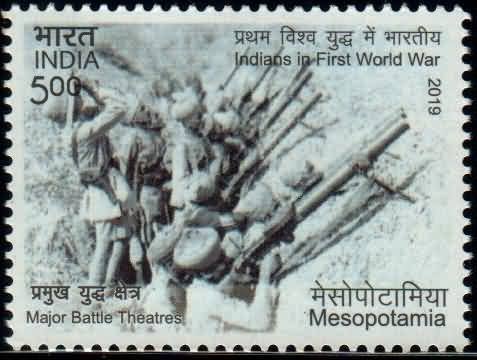Indian Expeditionary Force D in Mesopotamia

Technical Data
| Stamp Set | India in World War I : Major Battle Theatres |
|---|---|
| Date of Issue | August 20, 2019 |
| Denomination | Rs. 5 |
| Quantity | 500,000 |
| Perforation | 13¼ x 13¾ |
| Printer | Security Printing Press, Hyderabad |
| Printing Process | Wet Offset |
| Watermark | No Watermark |
| Colors | Multicolor |
| Credit (Designed By) | Sh. Brahm Prakash |
| Catalog Codes |
Michel IN 3546 Stamp Number IN 3131 Yvert et Tellier IN 3226 Stanley Gibbons IN 3624 |
| Themes | Army | Battle | First World War |
A Campaign of Courage and Sacrifice
The First World War (1914–1918) was one of the most defining events in modern world history, reshaping political and social structures across continents. Though India was still a British colony, it played an extraordinary role in the war, contributing significantly in terms of manpower, material, and morale. Among the major theatres of the war, the Mesopotamian campaign—fought by the Indian Expeditionary Force ‘D’—stands out as a remarkable chapter of courage, endurance, and strategic importance.
Formation and Deployment of Force ‘D’
The Indian Expeditionary Force ‘D’ (IEF D) was formed to secure British interests in the Persian Gulf and protect vital oil supplies from German and Ottoman threats. Initially deployed in Basra (present-day Iraq) in 1914, the force was composed primarily of Indian troops, reflecting India’s immense contribution to the war effort.
After initial operations to secure the Basra region, the mission expanded into a full-scale campaign against Ottoman forces in Mesopotamia. The difficult terrain, harsh climate, and lack of infrastructure made the campaign extremely challenging.
India’s Immense Contribution
India’s role in the Mesopotamian theatre was monumental. The country provided over three-quarters of the total force employed, over three-quarters of the river craft, and the entire railway material and personnel required for operations. Without India’s logistical and human resources, the success of the Mesopotamian campaign would have been impossible.
By the time Baghdad was captured in March 1917, the force had grown to 86 battalions, of which 73 were Indian, along with all but two of the 43 cavalry squadrons. This overwhelming Indian presence underlined the subcontinent’s central role in the campaign.
Challenges and Triumphs
The early stages of the campaign saw mixed fortunes. The siege of Kut-al-Amara (1916) resulted in a major setback when a large contingent of Indian and British troops was captured. However, the Indian Expeditionary Force soon reorganized and launched renewed offensives.
The eventual capture of Baghdad transformed the military situation in the Middle East and had far-reaching political effects. This victory boosted Allied morale and weakened the Ottoman Empire’s control over the region.
Acts of Gallantry and Recognition
The campaign was marked by numerous acts of bravery by Indian soldiers who fought with exceptional courage in hostile conditions. Three Indian soldiers were awarded the Victoria Cross, the highest military honour for gallantry, for their outstanding heroism in Mesopotamia.
Their steadfastness and sense of duty, despite severe hardships, earned admiration from military leaders across the Allied forces.
Legacy of the Mesopotamian Campaign
The success of the Indian Expeditionary Force ‘D’ in Mesopotamia not only showcased India’s military strength but also had lasting geopolitical implications. It contributed to the downfall of Ottoman rule in the Middle East and paved the way for a new political order in the region.
India’s role in this campaign demonstrated the professionalism and resilience of its soldiers, who fought far from home for a cause that reshaped the world.
Commemorative Recognition
In honour of the valour and sacrifice of the Indian Expeditionary Force ‘D’, the Department of Posts has issued a commemorative postage stamp. The stamp celebrates the indomitable spirit of the Indian soldiers who fought gallantly in the unforgiving deserts of Mesopotamia, immortalizing their courage as part of India’s proud military heritage.
